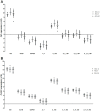Identification of Suitable Reference Genes for Investigating Gene Expression in Anterior Cruciate Ligament Injury by Using Reverse Transcription-Quantitative PCR
- PMID: 26192306
- PMCID: PMC4507999
- DOI: 10.1371/journal.pone.0133323
Identification of Suitable Reference Genes for Investigating Gene Expression in Anterior Cruciate Ligament Injury by Using Reverse Transcription-Quantitative PCR
Abstract
The anterior cruciate ligament (ACL) is one of the most frequently injured structures during high-impact sporting activities. Gene expression analysis may be a useful tool for understanding ACL tears and healing failure. Reverse transcription-quantitative polymerase chain reaction (RT-qPCR) has emerged as an effective method for such studies. However, this technique requires the use of suitable reference genes for data normalization. Here, we evaluated the suitability of six reference genes (18S, ACTB, B2M, GAPDH, HPRT1, and TBP) by using ACL samples of 39 individuals with ACL tears (20 with isolated ACL tears and 19 with ACL tear and combined meniscal injury) and of 13 controls. The stability of the candidate reference genes was determined by using the NormFinder, geNorm, BestKeeper DataAssist, and RefFinder software packages and the comparative ΔCt method. ACTB was the best single reference gene and ACTB+TBP was the best gene pair. The GenEx software showed that the accumulated standard deviation is reduced when a larger number of reference genes is used for gene expression normalization. However, the use of a single reference gene may not be suitable. To identify the optimal combination of reference genes, we evaluated the expression of FN1 and PLOD1. We observed that at least 3 reference genes should be used. ACTB+HPRT1+18S is the best trio for the analyses involving isolated ACL tears and controls. Conversely, ACTB+TBP+18S is the best trio for the analyses involving (1) injured ACL tears and controls, and (2) ACL tears of patients with meniscal tears and controls. Therefore, if the gene expression study aims to compare non-injured ACL, isolated ACL tears and ACL tears from patients with meniscal tear as three independent groups ACTB+TBP+18S+HPRT1 should be used. In conclusion, 3 or more genes should be used as reference genes for analysis of ACL samples of individuals with and without ACL tears.
Conflict of interest statement
Figures



Similar articles
-
Comprehensive selection of reference genes for expression studies in meniscus injury using quantitative real-time PCR.Gene. 2016 Jun 10;584(1):60-68. doi: 10.1016/j.gene.2016.03.005. Epub 2016 Mar 9. Gene. 2016. PMID: 26968891
-
Identification of suitable reference genes for gene expression studies in tendons from patients with rotator cuff tear.PLoS One. 2015 Mar 13;10(3):e0118821. doi: 10.1371/journal.pone.0118821. eCollection 2015. PLoS One. 2015. PMID: 25768100 Free PMC article.
-
Identification of suitable reference genes for gene expression studies of shoulder instability.PLoS One. 2014 Aug 14;9(8):e105002. doi: 10.1371/journal.pone.0105002. eCollection 2014. PLoS One. 2014. PMID: 25122470 Free PMC article.
-
Cervical cancer stem-like cells: systematic review and identification of reference genes for gene expression.Cell Biol Int. 2018 Feb;42(2):139-152. doi: 10.1002/cbin.10878. Epub 2017 Nov 9. Cell Biol Int. 2018. PMID: 28949053
-
Careful selection of reference genes is required for reliable performance of RT-qPCR in human normal and cancer cell lines.PLoS One. 2013;8(3):e59180. doi: 10.1371/journal.pone.0059180. Epub 2013 Mar 15. PLoS One. 2013. PMID: 23554992 Free PMC article. Review.
Cited by
-
A comparative study of effect of autograft compared with allograft anterior cruciate ligament reconstruction on expressions of LOXs and MMPs.Biosci Rep. 2017 Apr 28;37(2):BSR20160533. doi: 10.1042/BSR20160533. Print 2017 Apr 30. Biosci Rep. 2017. PMID: 28275205 Free PMC article.
-
The potential European genetic predisposition for non-contact anterior cruciate ligament injury.Knee Surg Sports Traumatol Arthrosc. 2018 Dec;26(12):3532-3536. doi: 10.1007/s00167-018-4974-7. Epub 2018 May 4. Knee Surg Sports Traumatol Arthrosc. 2018. PMID: 29728743
-
Reference genes for mesangial cell and podocyte qPCR gene expression studies under high-glucose and renin-angiotensin-system blocker conditions.PLoS One. 2021 Jul 9;16(7):e0246227. doi: 10.1371/journal.pone.0246227. eCollection 2021. PLoS One. 2021. PMID: 34242222 Free PMC article.
-
Anterior cruciate ligament and meniscal injuries in sports: incidence, time of practice until injury, and limitations caused after trauma.Rev Bras Ortop. 2016 Jul 20;51(6):652-656. doi: 10.1016/j.rboe.2016.04.008. eCollection 2016 Nov-Dec. Rev Bras Ortop. 2016. PMID: 28050535 Free PMC article.
-
A systemic approach to screening high-throughput RT-qPCR data for a suitable set of reference circulating miRNAs.BMC Genomics. 2020 Jan 31;21(1):111. doi: 10.1186/s12864-020-6530-3. BMC Genomics. 2020. PMID: 32005151 Free PMC article.
References
-
- Astur DC, Aleluia V, Santos CV, Arliani GG, Badra R, et al. (2012) Risks and consequences of using the transportal technique in reconstructing the anterior cruciate ligament: relationships between the femoral tunnel, lateral superior genicular artery and lateral epicondyle of the femoral condyle. Rev Bras Ortop 47: 5. - PMC - PubMed
-
- Astur DC, Aleluia V, Veronese C, Astur N, Oliveira SG, et al. (2014) A prospective double blinded randomized study of anterior cruciate ligament reconstruction with hamstrings tendon and spinal anesthesia with or without femoral nerve block. Knee 21: 911–915. 10.1016/j.knee.2014.06.003 - DOI - PubMed
Publication types
MeSH terms
Substances
LinkOut - more resources
Full Text Sources
Other Literature Sources
Medical
Research Materials
Miscellaneous

